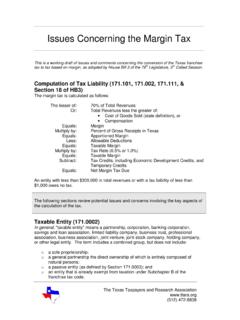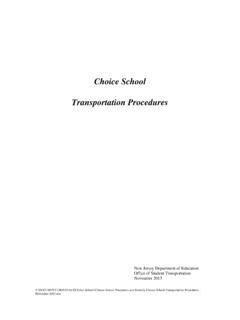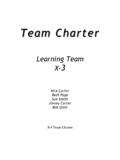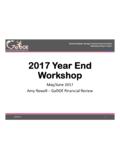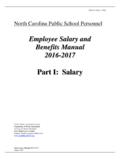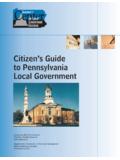Transcription of Introduction to School Finance-Text-2011 Final
1 An Introduction to to School finance in Texas Revised January 2012. Revised January 2012. TTARA. TTARA. 400 West 400 West 15. 15th Street, th Street,Suite Suite400. 400. Austin, Austin, TX. TX 78701. 78701. 512/472-8838. 512/472-8838. 512/472-2636 (fax). 512/472-2636 (fax). An Introduction to School finance in Texas Table of Contents Executive Summary 1. Total Funding (The Revenue Side) 3. Public Education Programs (The Spending Side) 5. Foundation School Program 8. The Formula System 8. Recapture of Local Property Taxes ( Robin Hood ) 19. The Target Revenue System and Property Tax Relief 22. Litigation and Legislation 25. Appendix 1 Tax Rate Ratification ( Rollback ) Elections 29. Appendix 2 - How Texas Compares to Other States 31. Appendix 3 Property Wealthy Districts Subject to Recapture 32. Appendix 4 Available Revenue at Compressed Tax Rates 36. TTARA Research Foundation Revised January 2012. An Introduction to School finance in Texas This is an update of the initial publication printed in May of 2010 and incorporates changes made by the 82nd Legislature in 2011.
2 TTARA Research Foundation Revised January 2012. An Introduction to School finance in Texas Executive Summary The public education system in Texas is one of the largest in the nation, with 1,280 School districts and charter schools containing 8,619 campuses. They employ 659,821 people 333,164 of whom are teachers to educate million enrolled students. Texas has more School districts than any other state and is second only to California in the number of students enrolled in its schools. Funding for the system is projected to total $ billion in the 2011-12 School year, which includes $ billion in state funds (43%), $ billion in local property taxes (45%), and $ billion in federal funds (12%). This $ billion is used to fund the basic School finance program as well as a variety of other cost items such as textbooks, state assessments, Regional Education Service Centers, adult literacy programs, schools for deaf and blind students, and schools for students incarcerated in the Department of Corrections.
3 In addition, the state contributed $ billion to the Teacher Retirement System for public education employees in the 2011-12. School year. Initiatives funded by grants outside of the formula system such as a teacher incentive pay program, the Student Success Initiative a grant program that focuses on college readiness, the early start pre-kindergarten grant program, and the High School Completion and Success Initiative, were funded at reduced levels or not funded at all for the 2011-12 and 2012-13 School years. These programs will most likely be re-evaluated in the 2013 legislative session. The state's School finance system is currently operating as two layered systems one based on the equalizing calculations of the Foundation School Program (FSP), and the other based on historical district funding levels known as the target revenue system.. The statutory goals of the Foundation School Program (FSP) are to guarantee that each School district in the state has adequate and equalized resources to provide a basic instructional program that meets state standards (as measured by the state's accountability system), provide equalized access to enrichment funds for those districts that choose to supplement their basic funding and provide facilities suitable to the student's educational needs.
4 Statutory formulas are used to calculate basic aid under Tier 1, enrichment funding under Tier 2, and facilities funding under an additional set of calculations. Once these costs are calculated, shares are apportioned between the state and local districts with the state sending funds to the districts for the state's share, and districts raising their share through the local property tax. Superimposed on top of the formulas is a target revenue system that the Legislature adopted in 2006 as a part of the property tax relief initiative. Districts were required to reduce their tax rates for maintenance and operations to two-thirds of their 2005 tax rate. To ensure that no district lost money due to the tax relief effort, the Legislature guaranteed that each district would receive no less than the amount of state and local revenue per weighted student ( student counts adjusted for certain higher cost educational factors) that they had received in the 2005-06 School year or would have received in the 2006-07 School year, whichever was greater (plus a few adjustments for funds added for high School students and teacher salaries).
5 The resulting amount was the district's adjusted revenue target, and essentially incorporates any historical funding discrepancies that were allowed in previous School finance packages. Further target revenue adjustments were added by the 2009 and 2011 Legislatures and as a result, districts are now compared by state and local revenue per weighted student available at the district's compressed tax rate. The 2011. Legislature passed a provision that will sunset the target revenue system on September 1, 2017 and directed that a joint interim committee appointed by the Speaker and Lt. Governor study the School finance system and recommend changes to the 2013 Legislature. Texas' formula-based system has been dwarfed by the target revenue system. Currently over four-fifths of all School districts receive their funding through the target revenue system rather than the state's traditional Foundation School Program formulas. This publication explains both sets of calculations used to calculate School aid, as well as appendices that examine tax rate ratification elections, a history of School finance litigation and resulting legislation, and comparisons of how Texas public education ranks relative to other states.
6 TTARA Research Foundation 1 Revised January 2012. An Introduction to School finance in Texas This page intentionally left blank TTARA Research Foundation 2 Revised January 2012. An Introduction to School finance in Texas An Introduction to School finance in Texas In the 2009-10 School year, public education in Texas was provided to million enrolled students by 1,280 School districts and charter schools 1,024 of those entities are independent School districts with the remainder comprised of special districts, state-administered districts and open-enrollment charter schools. School districts range in size from fewer than 20 enrolled students in San Vicente ISD to over 200,000 students in Houston ISD, although 86 percent of all School districts (containing 22 percent of the state's students) have less than 5,000 students. Texas has more School districts than any other state . over 7 percent of the nation's 17,807 districts and is second only to California in the number of students that are enrolled in public primary and secondary schools.
7 Texas School districts employ 659,821 people and encompass 8,619 campuses. Total Funding (The Revenue Side). As was the case in most states, Texas legislators faced difficult choices in creating the state budget for coming years when they met in the Spring of 2011. The use of $12 billion in one-time federal stimulus funds to balance the 2010-2011 state budget coupled with the lingering impacts of the economic recession, left the 82nd Legislature with an unprecedented revenue gap of $27 billion between what was needed to fully fund the 2012-2013 state budget based on existing laws, population growth estimates and the revenues expected to be available. Every part of the state budget was constrained, and public education was no exception. In the end, the Legislature appropriated $ billion for public education for the 2012-2013 biennium, a level that is $4 billion below the amount called for when current law formulas are fully funded considering estimates of enrollment growth and the impact of declining property values.
8 This amount includes state and federal funds plus $ billion in recaptured property taxes ( appropriated receipts ). that the Legislature treats as state funds (recapture is explained on page 19). Part of the $ billion will not actually be paid to School districts until September 2013, which is in the next state budget period. Funding for public education in the 2011-12 School year is projected to total $ billion. This includes local schools, Regional Education Service Centers, the State School for the Blind, State School for the Deaf, and state payments of $ billion to the Teacher Retirement System on behalf of public education employees. The total is comprised of $ billion in state funds (43%), $ billion in local property taxes (45%), and $ billion in federal funds (12%) for child nutrition programs, education for economically disadvantaged students, special education, and vocational and adult education programs; as well as a one-time payment of $830 million from the Federal Education Jobs Fund to assist School districts in retaining and training teachers (Figure 1).
9 Public Education in the State Budget. The Legislative Budget Office estimates that state and federal funding for public education in the 2012-2013 biennial state budget encompasses 29% percent of the All Funds biennial state budget, while state funding for public education comprises 45% percent of the General Revenue biennial budget (including the Property Tax Relief Fund). The Foundation School Fund, the Property Tax Relief Fund, the Instructional Materials Fund (formerly the textbook fund), the General Revenue Fund and the Available School Fund interact to provide basic state support for maintenance and operations and School facility costs. The majority of state aid to schools is formula driven, with general revenue making up the difference for what the other funds do not generate. Other state funds in support of public education include the Permanent School Fund an endowment fund generating investment income that is deposited into the Available School Fund and two other TTARA Research Foundation 3 Revised January 2012.
10 An Introduction to School finance in Texas funds that are used to allocate federal funds for health, education and welfare and the School lunch program. $ Figure 1. State, Local and Federal Funds for Public Education 2010 - 2013. Property Tax State Funds Federal Stimulus Replacing GR Federal Funds Federal Stimulus for Special Programs $ $ $ $ Preliminary $ 5% $ $ $ $ $ 10% $ 12%. 9% 11%. $ $ 8%. $ Billions of Dollars $ $ $ $ $ 33% 45% 43% 43%. $ $ $ $ $ $ $ $ 45% 45% 45% 46%. $ $ FY 2010 FY2011 FY 2012 FY 2013. Recaptured property taxes ("Appropriated Receipts") are included in the property tax total rather than state funds. August 2013 payment of $ billion is deferred until September 2013, but is included in state funds for FY 2013 for comparison purposes. Sources: HB 1 and HB 4 Conf. Comm. Reports, 82nd Legis. Regular Session; SB 2 Conf. Comm. Report, 82nd Legis. 1st Called Session Foundation School Fund. The Foundation School Fund is the mechanism through which most of the state revenue used to fund public education flows from the state to local districts.


